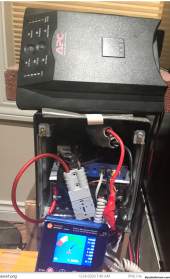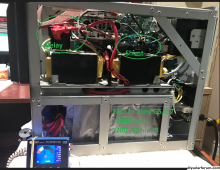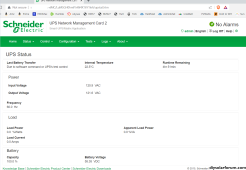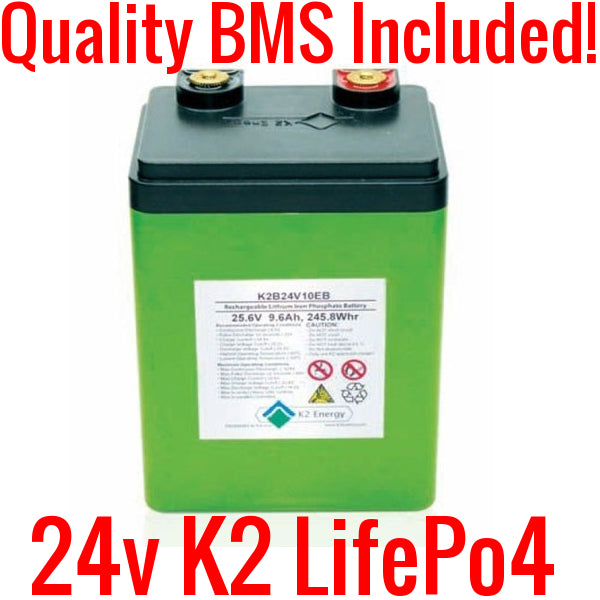DIYrich
Solar Wizard
good point. 30 amp diode?I don’t think the buck converter will play nice with being charged…
good point. 30 amp diode?I don’t think the buck converter will play nice with being charged…
Which BMS did you use with your UPS?I have been using an APC Smart UPS 1500 for about 15 years to provide backup power to multiple devices. I removed the internal batteries and brought out the wires to two 12v car batteries. This worked well but lead acid batteries are a pain, require maintenance, should not be discharged too much, and did not last that long (~3 years). A couple of years ago, I replaced them with eight 120AH LiFePo4 batteries for use on my current SMT1500. These are wonderful and I have had virtually no issues. The only minor issue is that the time remaining display is meaningless since I guess it assumes you only have the original batteries installed. So after a few minutes of a reasonably load, it sounds the warning beeper (which I have to manually silence) but it keeps running just fine for many hours or even days. I live in Northern CA where we have had power shutoffs for 2-3 days, but the UPS kept running the entire time under a fairly light load.
The UPS charges the batteries to 3.42v each, which is just about perfect (>99% charge.) It also automatically cuts the power at around 2.75v; also about perfect. I did use a BMS, although I am not sure I really needed it. Of course, the charging rate is low at about 3A, but since power outages are rare, this is not an issue. I do not care if it takes a week to recharge it, although I do have a 24v LiFePo4 charger just in case.
This works so well, I am actually in the process of upgrading them to 304AH batteries that I just received and will use my old batteries for a similar backup system at another house that still uses car batteries.
E read this part or not, but those drop in 10Ah LFP Batts only have like a 8 or so Amp max discharge...Thanks for the discussion in this thread, just sharing my experience testing LFP in a pretty cheap UPS in case it's helpful to anyone.
I have an old Cyberpower CST135XLU that I have been using for years as backup power for a wifi router and 1GBit switch and a couple of other small items. 45-watt total max load from the small amount of gear I have plugged into it.The UPS spec sheet lists "simulated sine wave" but it's worked fine with all the equipment I have on it. This is specifically a low-load situation so anyone with high load devices, desktop PCs etc is in a different boat obviously.
The standard SLAs need replacing every 2 years regardless how much use they do/don't get and they die unpredictably typically at the least convenient time. The UPS doesn't tell you they are dead so they happily sit there until the power goes off then shut down. I figured it's worth potentially wasting $80 (still cheaper than a set of the manufacturer spec SLAs) to see if LFPs work any better over time. I picked up a pair of Nermak 12v 10ah LifePO4 batteries as mentioned by another poster earlier in the thread and they fit great in this unit and seem to work as expected. Power up, self test passes etc.
Based on posts earlier in this thread about balancing batteries, BEFORE I put them in the unit I fully charged both batteries with a NOCO Genius G3500 in 12v Lithium mode (the charger set itself to 12v Lithium automatically but you can manually set it if needed) - it's not necessarily LFP specific but hopefully that doesn't matter (?)
30 min discharge test worked as expected, the % remaining counter on the unit started to count down from 100% etc. Load showed .024kW/26VA during that test, when wall power was restored the unit counted back up to 100% so it thinks it's discharging/recharging.
Obviously the longevity etc of the batteries and how the unit's charger maintains them etc is TBD.
I'd like to do a full rundown/recharge test running the batteries down until the unit shuts off, then let the unit recharge but I'm not sure the correct way to test if the batteries are being discharged/recharged in a balanced or imbalanced way? Not individual cells but the two separate 12v 10a battery packs. Just checking voltage with a meter I assume won't do it? I would appreciate suggestions for test approach or tools to monitor, how to identify the charge profile or links to posts that cover this sort of testing generically in a multi-battery setup, thanks in advance!
Yep, in my case the load will never go above 45w so it's not an issue but I did see the ~100w load max noted earlier.Not sure I'd youv
E read this part or not, but those drop in 10Ah LFP Batts only have like a 8 or so Amp max discharge...
Any load on the ups will shut them down fast...
Fine for super light electronics or so, but if over about 100W it'll fault the bms in them.
This is the info I've been looking for! I also have an old APC Smart UPS 1500, as well as an even older APC 1000, or 1200 watt model, that are both identical in size and number of 120 volt outlets on the back. I stopped buying replacement batteries for both of them several years ago, because the replacement batteries I could get would only last a little more than 1 year, before they were crap. I've recently been thinking about replacing the batteries with LiFePo batteries, but didn't know if I would need to replace any other components inside the UPS enclosure, to make it work. I don't mind doing a little modification work, to get a better system, but would like to reuse as much of the existing components as possible, while ending up with a much better UPS product in the end. If this means replacing the charging system and inverter, I'm willing to do that, but would love to get some guidance from someone who has already done what I'm trying to do. Any advice is greatly appreciated.I have been using an APC Smart UPS 1500 for about 15 years to provide backup power to multiple devices. I removed the internal batteries and brought out the wires to two 12v car batteries. This worked well but lead acid batteries are a pain, require maintenance, should not be discharged too much, and did not last that long (~3 years). A couple of years ago, I replaced them with eight 120AH LiFePo4 batteries for use on my current SMT1500. These are wonderful and I have had virtually no issues. The only minor issue is that the time remaining display is meaningless since I guess it assumes you only have the original batteries installed. So after a few minutes of a reasonably load, it sounds the warning beeper (which I have to manually silence) but it keeps running just fine for many hours or even days. I live in Northern CA where we have had power shutoffs for 2-3 days, but the UPS kept running the entire time under a fairly light load.
The UPS charges the batteries to 3.42v each, which is just about perfect (>99% charge.) It also automatically cuts the power at around 2.75v; also about perfect. I did use a BMS, although I am not sure I really needed it. Of course, the charging rate is low at about 3A, but since power outages are rare, this is not an issue. I do not care if it takes a week to recharge it, although I do have a 24v LiFePo4 charger just in case.
This works so well, I am actually in the process of upgrading them to 304AH batteries that I just received and will use my old batteries for a similar backup system at another house that still uses car batteries.




Well you have had much better luck that I have for the lifespan of replacement AGM batteries in your UPS systems. The last two times I have replaced my batteries with what I could find on Amazon, they only lasted just over a year before they were dead.I was thinking that it could be revenue from battery replacement but I really wonder how many people use OEM battery replacements. I have never purchased a single one in 20+ years! Several cheaper brands last just as long if you get them factory fresh. As for the price difference, the gap is really not that big between LFP and AGM.
I agree, it makes no sense to throw good money into bad equipment, but I'm willing to upgrade not only the batteries, but also the inverter and include a BMS, to make my old APC Smart UPS 1500 and even older 1000, or 1200 watt model, into a modern LiFePo backed up UPS. I just need the advice on which components to replace to make it work well, as I'm sure someone has already done all of the research to figure this out, if they are willing to share that info. I don't mind gutting the whole UPS and replacing everything, if that's what it takes, but obviously would like to salvage as much of the original UPS as possible, to minimize my project cost. I'm one of those guys who sees value in repairing and maintaining things, instead of trashing everything when it breaks, or wears out.I think we have created a monster with this thread. Please everyone research the model number of the UPS before throwing expensive batteries at it. The BX1500LCD is a stepped (non-sine) wave UPS. Go back and read the OP, and the printing on the underside of the UPS.
Additionally the H-bridge is designed to overheat just as the standard battery runs out of power. Adding expanded batteries will not extend the runtime. Even if you run at a fraction of the rated power, the internal timer may ignore the battery voltage and shutdown the UPS anyway.
As stated in post #12, I recommend the APC “XL” models that are bulletproof, pure sine and rated for continuous operation. Easy to identify by the external battery connector.
That’s why I don’t buy UPS batteries from Amazon, they are crap! I tried them twice and had the same results as you.Well you have had much better luck that I have for the lifespan of replacement AGM batteries in your UPS systems. The last two times I have replaced my batteries with what I could find on Amazon, they only lasted just over a year before they were dead.
I am not 100% sure that would work.I agree, it makes no sense to throw good money into bad equipment, but I'm willing to upgrade not only the batteries, but also the inverter and include a BMS, to make my old APC Smart UPS 1500 and even older 1000, or 1200 watt model, into a modern LiFePo backed up UPS. I just need the advice on which components to replace to make it work well, as I'm sure someone has already done all of the research to figure this out, if they are willing to share that info. I don't mind gutting the whole UPS and replacing everything, if that's what it takes, but obviously would like to salvage as much of the original UPS as possible, to minimize my project cost. I'm one of those guys who sees value in repairing and maintaining things, instead of trashing everything when it breaks, or wears out.

 batteryhookup.com
batteryhookup.com
Likely a 6Ah BMS is too limiting for the ups to pass the self test. Could be as little as a 3 amp flow limit, and the ups may pull 10A on self test.UPS: Belkin Battery Backup BU3DC001-12V Revision B
Works fine with regular 12v/7ah LA (same dimensions as the Chins battery used by the OP)
Does not work with a 'DC HOUSE' 12.8v/6ah LFPo. Even w the switch in the back set to 'OFF', the UPS is trying to interact with the battery, and emits a beep error, followed by a long tone. Could not get as far as load-testing. ASIN B0972NRPG4
It's rated at 6. The UPS has a max load of 36 watts. But the self-test could be higher.Likely a 6Ah BMS is too limiting for the ups to pass the self test. Could be as little as a 3 amp flow limit, and the ups may pull 10A on self test.
And.. Can you suggest an LFPO that has a better peak load allowance? In the same form factor.Likely a 6Ah BMS is too limiting for the ups to pass the self test. Could be as little as a 3 amp flow limit, and the ups may pull 10A on self test.
Nope, that’s the issue.And.. Can you suggest an LFPO that has a better peak load allowance? In the same form factor.


